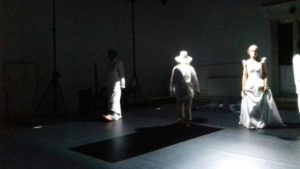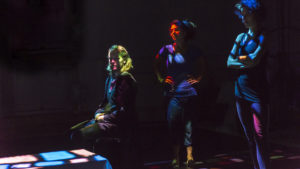
THE ACTOR LIKE SHAMAN
A study in transformation and presence.
“The actor as Shaman” is a research project with and by the Olske Orchestra’s company of 6 actors and its director. Through our many years of collaboration, we have already gained joint experience from up to several theater productions and research projects and are thus a group with a fairly good knowledge of each other’s competencies and working methods, which can give us the opportunity to get deep into our study.
With the experiment “The actor as Shaman” we want to find a common language and some useful tools to work with presence on stage, both for the value of the study itself and the sharing it brings about at the Experimental Station and as a strengthening of our collaboration and development of our skills, which will indirectly benefit future joint productions.
The experiment holds 2-3 open sessions along the way with i.a. participation of students and lecturers from Theater and Performance Studies at the University of Copenhagen. The final report will be included as part of the material in the overall documentation of the Olske Orchestra’s performance trilogy: “A nation’s self-hatred – Denmark between shame and self-overestimation”.
Names and professional background of the participants in the experiment.
The actors / performers: Morten Klode, Angelina Watson, Øyvind Kirchhoff, Ditte Laumann, Sofie Ebbesen and Mirea Serra as well as director Lotte Faarup. Schedule for the experiment. All Thursday between d. 30 August 2018 to d. January 17, 2019 at 19 – 22 (minus holidays etc.) in total: 14 times.
The starting point for the experiment
We are based on a claim that the actor must enter a different state on stage, far from his private being, just like when the shaman is working. When we say Shaman it is because we think of the actor as a medium, a transformer, a translator, a convert, a communicator, an interpreter… who lends his body and his voice to a given theatrical material, which is allowed to pass through the actor , be influenced by his personality and intuition and eventually reach his recipient: the audience. But how to reach this state? What does it take to put one’s private being away but retain one’s full personality? What does the theatrical presence require; both listening to what is conveyed and listening to those who receive? How to work with these concepts, also e.g. in a very tight technical framework? We know that it requires great concentration and precise boundaries. We have a feeling that it is necessary to empty oneself in order to be filled and be a messenger of history with its presence and all its personality made available. We know the experience when we ourselves are the audience, when we are conveyed a story / thought / song / image of a person we see working, with a selfless and deeply concentrated presence. But what exercises, what concrete tools can we find, us 7 performing artists with our background, that can help us step into such a state? We will try to answer that with this experiment.
Course of action
We are inspired by Odin Theatre’s basic understanding of the actor’s personal training, Nadine George’s voice training technique and the Italian dance company Compagnia Abbondanza Bertoni’s working method and approach to stage presence. In addition, we are inspired by i.a. the Finnish architect Juhani Pallasmaa’s book Arkitekturen og sanserne, (Arkitektens forlag 2014), especially due to his thoughts on bodily perception. For common inspiration, everyone reads Lotte Faarup’s essay: “I am the space where I am”, Peripeti no. 26 – 2017. In addition, all participants provide ongoing with their own practical and theoretical experience through joint conversations and exercises. We imagine working with both voice training exercises and physical exercises as well as exercises that are developed and invented based on this work. Each work session lasts 3 hours and always starts with a warm-up aimed at the specific exercises of the day. Work is done in a large white room with high ceilings (Boulevarden, Forsøgsstationen), everyone wears training clothes and occasionally uses music as well as materials such as: chairs, tables, clothes, food and various other props. Being the audience for each other’s work, ie helping the performer with audience contact, will have a great function.













